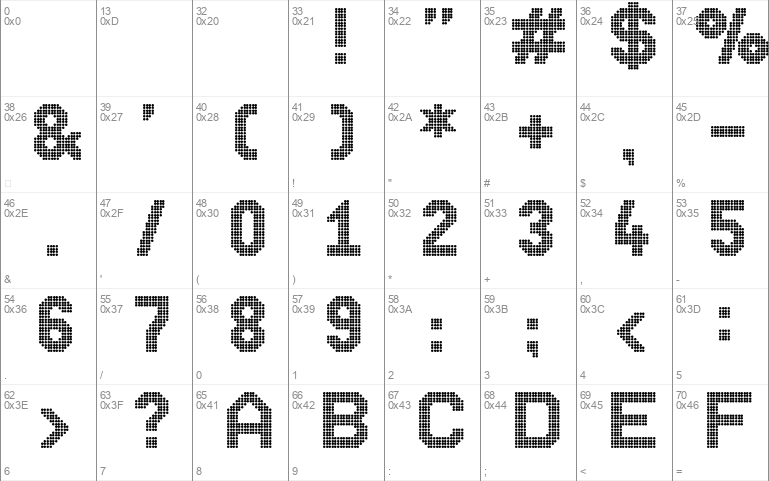
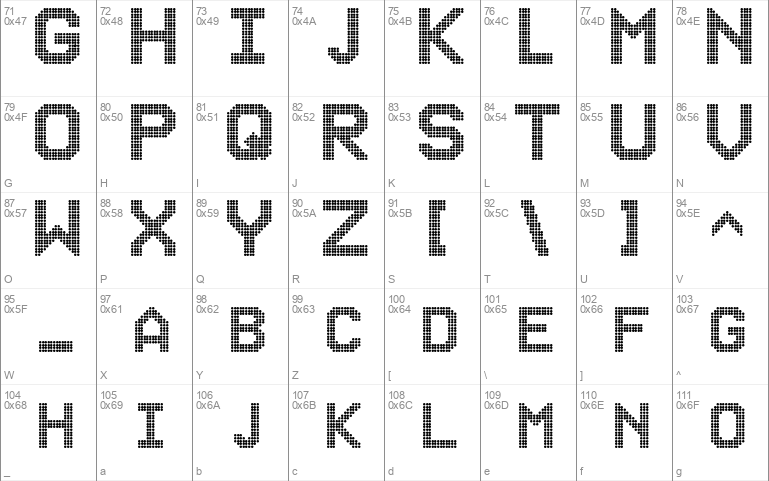
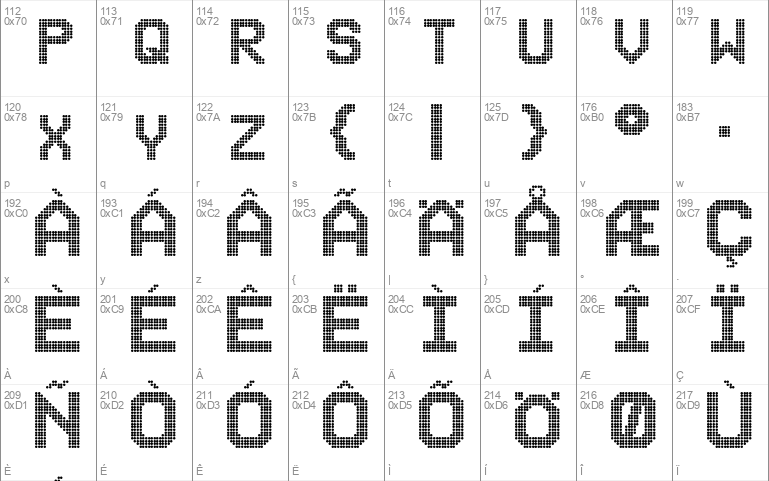
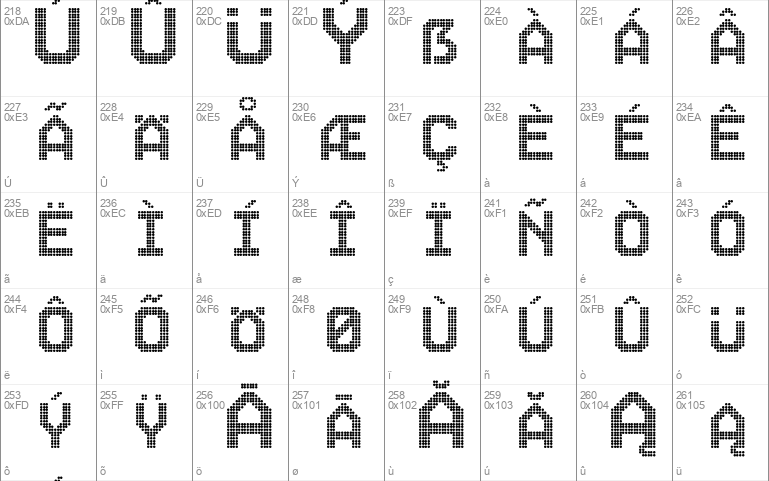
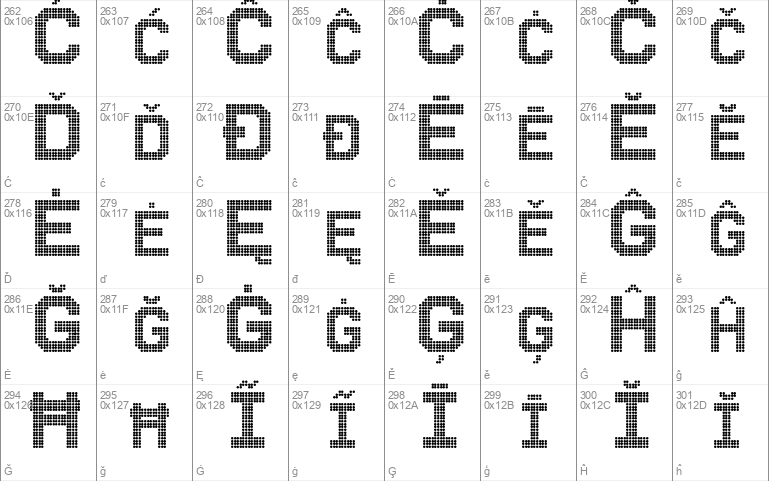

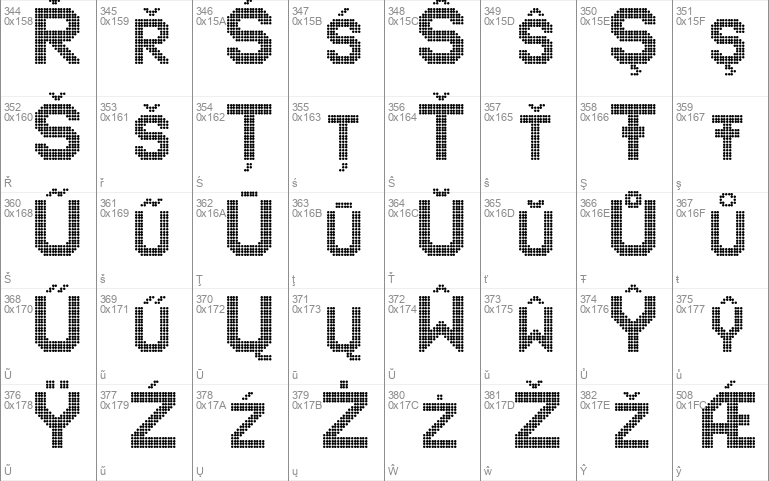
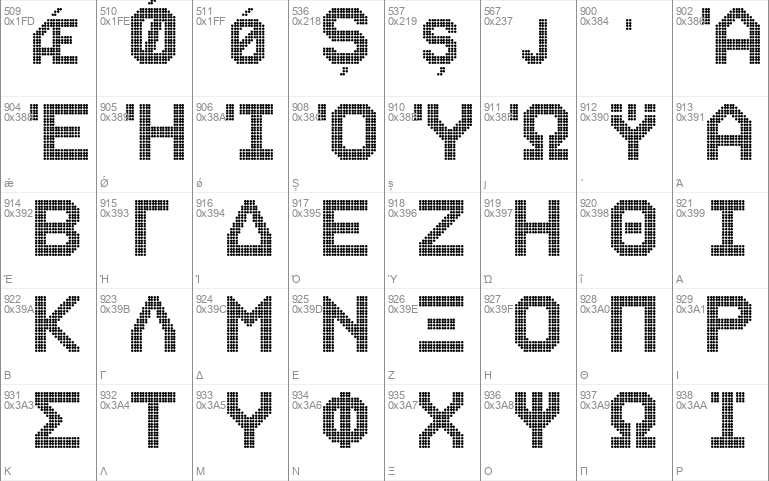
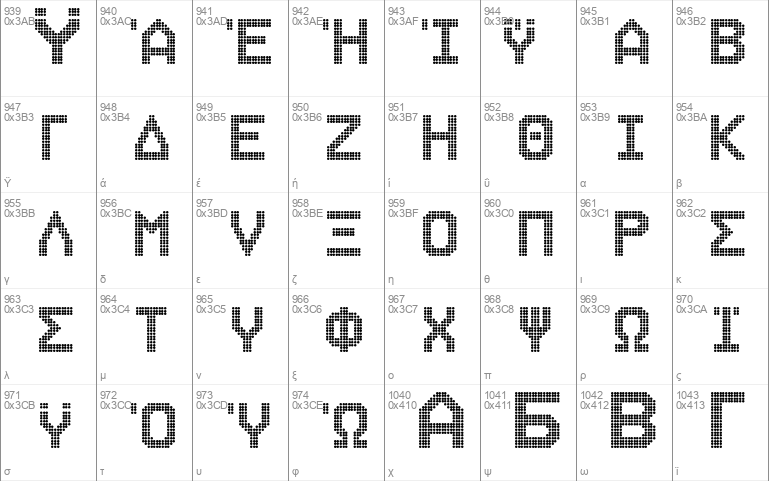
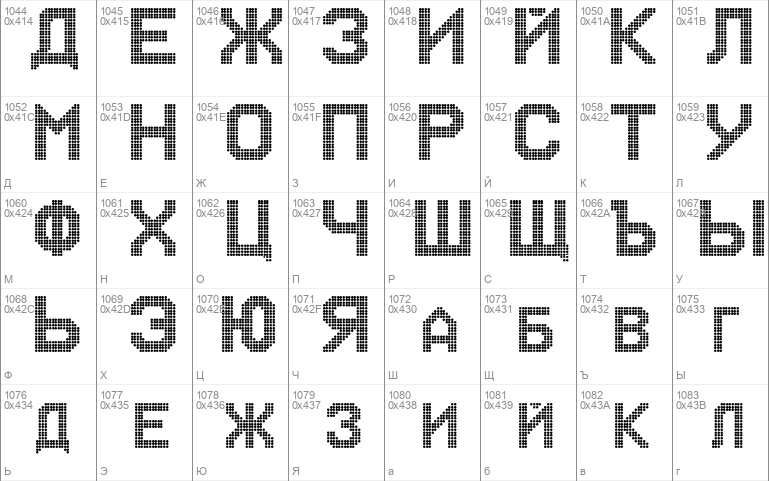

- Styles (1)
- Character Maps
- License











- Free for Personal Use
- Free for Commercial Use
- Modification Allowed
- Redistribution Allowed
Extended information
September 18, ein Forenmitglied zeigt die Buchstaben einer 1976 installierten Stadionanzeige und fragt nach der dort verwendeten Schrift. Schnell zeigt sich, dass diese damals als reine Digital-Zeichensat-ROM schrift bit f
Read more
SIL-Openfont-Lizenz
Deutsche Übersetzung (rechtlich bindend ist nur die Originalversion)
Version 1.1 - 26. Februar 2007
VORBEMERKUNG
Das Ziel der Open Font License (OFL) besteht darin, die weltweite Entwicklung von kollaborativen Schriftprojekten anzuregen, die Maßnahmen zur Erstellung von Schriften im akademischen und linguistischen Umfeld zu unterstützen und eine freie und offene Rahmenstruktur zu bieten, in der Schriftarten ausgetauscht und in Zusammenarbeit mit anderen verbessert werden können.
Die OFL erlaubt die uneingeschränkte Nutzung, Analyse, Änderung und Weiterverbreitung der lizenzierten Schriftarten, sofern sie nicht verkauft werden. Die Schriften einschließlich etwaiger Bearbeitungen können mit jeder beliebigen Software gebündelt, weiterverbreitet und/oder verkauft und darin eingebettet werden, vorausgesetzt, dass für die Bearbeitungen keine reservierten Namen verwendet werden. Die Schriften und Bearbeitungen dürfen jedoch nicht im Rahmen einer anderen Art von Lizenz veröffentlicht werden. Die Verpflichtung, Schriftarten innerhalb dieser Lizenz zu belassen, gilt nicht für Dokumente, die unter Verwendung der Schriften oder der zugehörigen Bearbeitungen erstellt wurden.
DEFINITIONEN
„Schriftsoftware“ bezeichnet die Gruppe von Dateien, die von den Urheberrechtsinhabern gemäß dieser Lizenz herausgegeben und deutlich als solche gekennzeichnet wurden. Das kann Quelldateien, Build-Skripte und Dokumentation umfassen.
„Reservierter Schriftname“ bezeichnet alle Namen, die nach den Urheberrechtshinweisen als solche angegeben sind.
„Originalversion“ bezeichnet die Sammlung der von den Urheberrechtsinhabern verbreiteten Komponenten der Schriftsoftware.
„Geänderte Version“ bezeichnet Bearbeitungen, die dadurch entstehen, dass Komponenten der Originalversion im Ganzen oder in Teilen hinzugefügt, gelöscht oder ersetzt oder Formate geändert werden oder die Schriftsoftware in eine neue Umgebung übertragen wird.
„Urheber“ bezeichnet Designer, Techniker, technische Autoren oder andere Personen, die einen Beitrag zur Schriftsoftware geleistet haben.
GENEHMIGUNG & BEDINGUNGEN
Hiermit wird jeder Person, die eine Kopie der Schriftsoftware erwirbt, die unentgeltliche Genehmigung erteilt, zu folgenden Bedingungen veränderte und nicht veränderte Kopien der Software zu nutzen, zu analysieren, zu kopieren, zusammenzuführen, einzubetten, zu ändern, weiter zu verbreiten und zu verkaufen:
1) Die Schriftsoftware und ihre einzelnen Komponenten dürfen weder in Originalversion noch in abgeänderter Version verkauft werden.
2) Die Originalversion und die geänderte Version der Schriftsoftware darf mit jeder Software gebündelt, weiter verbreitet und/oder verkauft werden, vorausgesetzt, dass jede Kopie den vorstehenden Urheberrechtshinweis und diese Lizenz enthält. Diese können entweder als separate Textdateien, vom Menschen lesbare Kopfzeilen oder in entsprechenden maschinenlesbaren Metadaten-Feldern in Textdateien oder binären Dateien eingefügt werden, solange der Benutzer diese Felder problemlos einsehen kann.
3) Für geänderte Versionen der Software dürfen die reservierten Schriftnamen nur dann verwendet werden, wenn der jeweilige Urheberrechtsinhaber hierfür eine ausdrückliche schriftliche Genehmigung erteilt. Diese Einschränkung gilt nur für den primären Schriftnamen gemäß Darstellung für die Benutzer.
4) Die Namen der Urheberrechtsinhaber oder der Urheber dürfen nicht benutzt werden, um eine geänderte Version zu fördern, zu unterstützen oder zu bewerben, ausgenommen zur Anerkennung der Beiträge der Urheberrechtsinhaber und Urheber oder mit deren ausdrücklicher schriftlicher Genehmigung.
5) Die Schriftsoftware – ganz gleich, ob verändert oder nicht verändert, teilweise oder ganz – darf nur im Rahmen dieser Lizenz verbreitet werden, jedoch nicht im Rahmen einer anderen Lizenz. Die Verpflichtung, Schriften nur im Rahmen dieser Lizenz zu verbreiten, gilt nicht für Dokumente, die unter Verwendung der Schriftsoftware erstellt wurden.
BEENDIGUNG
Diese Lizenz wird ungültig, falls eine der vorstehenden Bedingungen nicht erfüllt ist.
HAFTUNGSAUS
Eine kurze deutsche Zusammenfassung der OFL finden Sie auf:
http://de.wikipedia.org/wiki/SIL_Open_Font_License
OFL FAQ - Frequently Asked Questions about the SIL Open Font License (OFL)
Version 1.1-update1 - 31 March 2009
(See http://scripts.sil.org/OFL for updates)
1 ABOUT USING AND DISTRIBUTING FONTS LICENSED UNDER THE OFL
1.1 Can I use the fonts in any publication, even embedded in the file?
Yes. You may use them like most other fonts, but unlike some fonts you may include an embedded subset of the fonts in your document. Such use does not require you to include this license or other files (listed in OFL condition 2), nor does it require any type of acknowledgement within the publication. Some mention of the font name within the publication information (such as in a colophon) is usually appreciated. If you wish to include the complete font as a separate file, you should distribute the full font package, including all existing acknowledgements, and comply with the OFL conditions. Of course, referencing or embedding an OFL font in any document does not change the license of the document itself. The requirement for fonts to remain under the OFL does not apply to any document created using the fonts and their derivatives. Similarly, creating any kind of graphic using a font under OFL does not make the resulting artwork subject to the OFL.
1.2 Can I make web pages using these fonts?
Yes! Go ahead! Using CSS (Cascading Style Sheets) is recommended. Direct usage of fonts retrieved from a remote server - also referred to as font linking - using cross-platform open standards like @font-face is encouraged. This is considered to be use and distribution for which the OFL explicitly grants permission. The font file itself is not embedded in the webpage but referenced through a web address (i.e. a URI regardless of file format or access protocol) which will cause the browser to retrieve and use the corresponding font to render the webpage. This usage scenario is different from font embedding within a document (i.e. a PDF) where the font or some of its elements become part of the document. Note that embedding in a document is also permitted by the license as indicated in 1.1. (See 1.10 for details related to URL-based access restrictions methods or DRM mechanisms).
1.3 Can I make the fonts available to others from my web site?
Yes, as long as you meet the conditions of the license (do not sell by itself, include the necessary files, include the necessary copyright and license information, rename Modified Versions, do not abuse the Author(s)' name(s) and do not sublicense). In the case where you are hosting fonts to be served on the web, make sure the file contains the needed copyright notice(s) and licensing information in its metadata. Please double-check the accuracy of every field to prevent contradictory information. If you are making the font available for use via the @font-face open standard, putting this information in the standard font metadata fields is sufficient. Other font formats, including EOT and proposed superior alternatives, already provide fields for this information.
1.4 Can the fonts be included with Free/Libre and Open Source Software collections such as GNU/Linux and BSD distributions?
Yes! Fonts licensed under the OFL can be freely aggregated with software under FLOSS (Free/Libre and Open Source Software) licenses. Since fonts are much more useful aggregated to than merged with existing software, possible incompatibility with existing software licenses is not a problem. You can also repackage the fonts and the accompanying components in a .rpm or .deb package and include them in distro CD/DVDs and online repositories.
1.5 I want to distribute the fonts with my program. Does this mean my program also has to be free/libre and open source software?
No. Only the portions based on the Font Software are required to be released under the OFL. The intent of the license is to allow aggregation or bundling with software under restricted licensing as well.
1.6 Can I include the fonts on a CD of freeware or commercial fonts?
Yes, as long some other font or software is also on the disk, so the OFL font is not sold by itself.
1.7 Can I sell a software package that includes these fonts?
Yes, you can do this with both the Original Version and a Modified Version. Examples of bundling made possible by the OFL would include: word processors, design and publishing applications, training and educational software, edutainment software, etc.
1.8 Why won't the OFL let me sell the fonts alone?
The intent is to keep people from making money by simply redistributing the fonts. The only people who ought to profit directly from the fonts should be the original authors, and those authors have kindly given up potential direct income to distribute their fonts under the OFL. Please honor and respect their contribution!
1.9 I've come across a font released under the OFL. How can I easily get more information about the Original Version? How can I know where it stands compared to the Original Version or other Modified Versions?
Consult the copyright statement(s) in the license for ways to contact the original authors. Consult the FONTLOG for information on how the font differs from the Original Version, and get in touch with the various contributors via the information in the acknowledgment section. Please consider using the Original Versions of the fonts whenever possible.
1.10 What do you mean in condition 4? Can you provide examples of abusive promotion / endorsement / advertisement vs. normal acknowledgement?
The intent is that the goodwill and reputation of the author(s) should not be used in a way that makes it sound like the original author(s) endorse or approve of a specific Modified Version or software bundle. For example, it would not be right to advertise a word processor by naming the author(s) in a listing of software features, or to promote a Modified Version on a web site by saying "designed by ...". However, it would be appropriate to acknowledge the author(s) if your software package has a list of people who deserve thanks. We realize that this can seem to be a gray area, but the standard used to judge an acknowledgement is that if the acknowledgement benefits the author(s) it is allowed, but if it primarily benefits other parties, or could reflect poorly on the author(s), then it is not.
1.11 Can Font Software released under the OFL be subject to URL-based access restrictions methods or DRM mechanisms?
Yes, but these issues are out-of-scope for the OFL. The license itself neither encourages their use nor prohibits them since such mechanisms are not implemented in the components of the Font Software but through external software. Such restrictions are put in place for many different purposes corresponding to various usage scenarios. One common example is to limit potentially dangerous cross-site scripting attacks. However, in the spirit of libre/open fonts and unrestricted writing systems, we strongly encourage open sharing and reuse of OFL fonts, and the establishment of an environment where such restrictions are unnecessary. Note that whether you wish to use such mechanisms or you prefer not to, you must still abide by the rules set forth by the OFL when using fonts released by their authors under this license. Derivative fonts must be licensed under the OFL, even if they are part of a service for which you charge fees and/or for which access to source code is restricted. You may not sell the fonts on their own - they must be part of a larger software package or bundle. For example, even if the OFL font is distributed in a software package or via an online service using a DRM mechanism, the user would still have the right to extract that font, use, study, modify and redistribute it under the OFL.
1.12 What about distributing fonts with a document? Within a compressed folder structure like an OpenDocument file (.odt) for example? Is it redistribution, bundling or embedding?
The vast majority of the time, documents circulated in electronic form reference a font name which will match the corresponding font on the target system but do not carry the font within themselves. There may, however, be some cases where you need to bundle a font with the document. Certain document formats may allow the inclusion of an unmodified font within their file structure which consists of a compressed folder containing the various resources forming the document (such as pictures and thumbnails). Including fonts within such a structure is understood as being different from embedding but rather similar to bundling (or mere aggregation) for which the licensing makes explicit provision. In this case the font is conveyed unchanged whereas embedding a font transforms it from the original format. The OFL does not allow anyone to extract the font from such a structure to then redistribute it under another license. The explicit permission to redistribute and embed does not cancel the requirement for the Font Software to remain under the license chosen by its Author(s).
1.13 If OFL fonts are extracted from a document in which they are embedded (such as a PDF file), what can be done with them? Is this a risk to Author(s)?
The few utilities that can extract fonts embedded in a PDF will only output limited amounts of outlines - not a complete font. To create a working font from this method is much more difficult than finding the source of the original OFL font. So there is little chance that an OFL font would be extracted and redistributed inappropriately through this method. Even so, copyright laws address any misrepresentation of authorship. All Font Software released under the OFL and marked as such by the Author(s) is intended to remain under this license regardless of the distribution method, and cannot be redistributed under any other license. We strongly discourage any font extraction - we recommend directly using the font sources instead - but if you extract font outlines from a document please be considerate, use your common sense and respect the work of the Author(s) and the licensing model.
1.14 What about sharing OFL fonts with friends on a CD, DVD or USB stick?
You are very welcome to share open fonts with friends, family and colleagues on such removable media. Please make sure that you share and share-alike as much as possible from what the Author(s) released and that you don't strip away useful information which may not be present in the binary font files themselves. Just remember that in the case where you sell the font, it has to come bundled with software.
2 ABOUT MODIFYING OFL LICENSED FONTS
2.1 Can I change the fonts? Are there any limitations to what things I can and cannot change?
You are allowed to change anything, as long as such changes do not violate the terms of the license. In other words, you are not allowed to remove the copyright statement(s) from the font, but you could add additional information into it that covers your contribution.
2.2 I have a font that needs a few extra glyphs - can I take them from an OFL licensed font and copy them into mine?
Yes, but if you distribute that font to others it must be under the OFL, and include the information mentioned in condition 2 of the license.
2.3 Can I charge people for my additional work? In other words, if I add a bunch of special glyphs and/or OpenType/Graphite code, can I sell the enhanced font?
Not by itself. Derivative fonts must be released under the OFL and cannot be sold by themselves. It is permitted, however, to include them in a larger software package (such as text editors, office suites or operating systems), even if the larger package is sold. In that case, you are strongly encouraged, but not required, to also make that derived font easily and freely available outside of the larger package.
2.4 Can I pay someone to enhance the fonts for my use and distribution?
Yes. This is a good way to fund the further development of the fonts. Keep in mind, however, that if the font is distributed to others it must be under the OFL. You won't be able to recover your investment by exclusively selling the font, but you will be making a valuable contribution to the community. Please remember how you have benefitted from the contributions of others.
2.5 I need to make substantial revisions to the font to make it work with my program. It will be a lot of work, and a big investment, and I want to be sure that it can only be distributed with my program. Can I restrict its use?
No. If you redistribute a Modified Version of the font it must be under the OFL. You may not restrict it in any way. This is intended to ensure that all released improvements to the fonts become available to everyone. But you will likely get an edge over competitors by being the first to distribute a bundle with the enhancements. Again, please remember how you have benefitted from the contributions of others.
2.6 Do I have to make any derivative fonts (including extended source files, build scripts, documentation, etc.) publicly available?
No, but please do share your improvements with others. You may find that you receive more than what you gave in return.
2.7 Why can't I use the Reserved Font Name(s) in my derivative font names? I'd like people to know where the design came from.
The best way to acknowledge the source of the design is to thank the original authors and any other contributors in the files that are distributed with your revised font (although no acknowledgement is required). The FONTLOG is a natural place to do this. Reserved Font Name(s) ensure that the only fonts that have the original names are the unmodified Original Versions. This allows designers to maintain artistic integrity while allowing collaboration to happen. It eliminates potential confusion and name conflicts. When choosing a name be creative and avoid names that reuse almost all the same letters in the same order or sound like the original. Keep in mind that the Copyright Holder(s) can allow a specific trusted partner to use Reserved Font Name(s) through a separate written agreement.
2.8 What do you mean by "primary name as presented to the user"? Are you referring to the font menu name?
Yes, the requirement to change the visible name used to differentiate the font from others applies to the font menu name and other mechanisms to specify a font in a document. It would be fine, for example, to keep a text reference to the original fonts in the description field, in your modified source file or in documentation provided alongside your derivative as long as no one could be confused that your modified source is the original. But you cannot use the Reserved Font Names in any way to identify the font to the user (unless the Copyright Holder(s) allow(s) it through a separate agreement; see section 2.7). Users who install derivatives ("Modified Versions") on their systems should not see any of the original names ("Reserved Font Names") in their font menus, for example. Again, this is to ensure that users are not confused and do not mistake a font for another and so expect features only another derivative or the Original Version can actually offer. Ultimately, creating name conflicts will cause many problems for the users as well as for the designer of both the Original and Modified versions, so please think ahead and find a good name for your own derivative. Font substitution systems like fontconfig, or application-level font fallback configuration within OpenOffice.org or Scribus, will also get very confused if the name of the font they are configured to substitute to actually refers to another physical font on the user's hard drive. It will help everyone if Original Versions and Modified Versions can easily be distinguished from one another and from other derivatives. The substitution mechanism itself is outside the scope of the license. Users can always manually change a font reference in a document or set up some kind of substitution at a higher level but at the lower level the fonts themselves have to respect the Reserved Font Name(s) requirement to prevent ambiguity. If a substitution is currently active the user should be aware of it.
2.9 Am I not allowed to use any part of the Reserved Font Names?
You may not use the words of the font names, but you would be allowed to use parts of words, as long as you do not use any word from the Reserved Font Names entirely. We do not recommend using parts of words because of potential confusion, but it is allowed. For example, if "Foobar" was a Reserved Font Name, you would be allowed to use "Foo" or "bar", although we would not recommend it. Such an unfortunate choice would confuse the users of your fonts as well as make it harder for other designers to contribute.
2.10 So what should I, as an author, identify as Reserved Font Names?
Original authors are encouraged to name their fonts using clear, distinct names, and only declare the unique parts of the name as Reserved Font Names. For example, the author of a font called "Foobar Sans" would declare "Foobar" as a Reserved Font Name, but not "Sans", as that is a common typographical term, and may be a useful word to use in a derivative font name. Reserved Font Names should also be single words. A font called "Flowing River" should have Reserved Font Names "Flowing" and "River", not "Flowing River".
2.11 Do I, as an author, have to identify any Reserved Font Names?
No, but we strongly encourage you to do so. This is to avoid confusion between your work and Modified versions. You may, however, give certain trusted parties the right to use any of your Reserved Font Names through separate written agreements. For example, even if "Foobar" is a RFN, you could write up an agreement to give company "XYZ" the right to distribute a modified version with a name that includes "Foobar". This allows for freedom without confusion.
2.12 Are any names (such as the main font name) reserved by default?
No. That is a change to the license as of version 1.1. If you want any names to be Reserved Font Names, they must be specified after the copyright statement(s).
2.13 What is this FONTLOG thing exactly?
It has three purposes: 1) to provide basic information on the font to users and other developers, 2) to document changes that have been made to the font or accompanying files, either by the original authors or others, and 3) to provide a place to acknowledge the authors and other contributors. Please use it! See below for details on how changes should be noted.
2.14 Am I required to update the FONTLOG?
No, but users, designers and other developers might get very frustrated at you if you don't! People need to know how derivative fonts differ from the original, and how to take advantage of the changes, or build on them.
3 ABOUT THE FONTLOG
The FONTLOG can take a variety of formats, but should include these four sections:
3.1 FONTLOG for
This file provides detailed information on the
3.2 Basic Font Information
(Here is where you would describe the purpose and brief specifications for the font project, and where users can find more detailed documentation. It can also include references to how changes can be contributed back to the Original Version. You may also wish to include a short guide to the design, or a reference to such a document.)
3.3 ChangeLog
(This should list both major and minor changes, most recent first. Here are some examples:)
7 February 2007 (Pat Johnson)
- Added Greek and Cyrillic glyphs
- Released as "
7 March 2006 (Fred Foobar)
- Tweaked contextual behaviours
- Released as "
1 Feb 2005 (Jane Doe)
- Improved build script performance and verbosity
- Extended the smart code documentation
- Corrected minor typos in the documentation
- Fixed position of combining inverted breve below (U+032F)
- Added OpenType/Graphite smart code for Armenian
- Added Armenian glyphs (U+0531 -> U+0587)
- Released as "
1 Jan 2005 (Joe Smith)
- Initial release of font "
3.4 Acknowledgements
(Here is where contributors can be acknowledged.
If you make modifications be sure to add your name (N), email (E), web-address (W) and description (D). This list is sorted by last name in alphabetical order.)
N: Jane Doe
E: [email protected]
W: http://art.university.edu/projects/fonts
D: Contributor - Armenian glyphs and code
N: Fred Foobar
E: [email protected]
W: http://foobar.org
D: Contributor - misc Graphite fixes
N: Pat Johnson
E: [email protected]
W: http://pat.fontstudio.org
D: Designer - Greek & Cyrillic glyphs based on Roman design
N: Tom Parker
E: [email protected]
W: http://www.company.com/tom/projects/fonts
D: Engineer - original smart font code
N: Joe Smith
E: [email protected]
W: http://joe.fontstudio.org
D: Designer - original Roman glyphs
(Original authors can also include information here about their organization.)
4 ABOUT MAKING CONTRIBUTIONS
4.1 Why should I contribute my changes back to the original authors?
It would benefit many people if you contributed back to what you've received. Providing your contributions and improvements to the fonts and other components (data files, source code, build scripts, documentation, etc.) could be a tremendous help and would encourage others to contribute as well and 'give back', which means you will have an opportunity to benefit from other people's contributions as well. Sometimes maintaining your own separate version takes more effort than merging back with the original. Be aware that any contributions, however, must be either your own original creation or work that you own, and you may be asked to affirm that clearly when you contribute.
4.2 I've made some very nice improvements to the font, will you consider adopting them and putting them into future Original Versions?
Most authors would be very happy to receive such contributions. Keep in mind that it is unlikely that they would want to incorporate major changes that would require additional work on their end. Any contributions would likely need to be made for all the fonts in a family and match the overall design and style. Authors are encouraged to include a guide to the design with the fonts. It would also help to have contributions submitted as patches or clearly marked changes (the use of smart source revision control systems like subversion, svk, mercurial, git or bzr is a good idea). Examples of useful contributions are bug fixes, additional glyphs, stylistic alternates (and the smart font code to access them) or improved hinting.
4.3 How can I financially support the development of OFL fonts?
It is likely that most authors of OFL fonts would accept financial contributions - contact them for instructions on how to do this. Such contributions would support future development. You can also pay for others to enhance the fonts and contribute the results back to the original authors for inclusion in the Original Version.
(In case of the font, that comes with this copy of the FAQ-file, you will find a paypal(tm) donation link on the fonts-page of www.peter-wiegel.de)
5 ABOUT THE LICENSE
5.1 I see that this is version 1.1 of the license. Will there be later changes?
Version 1.1 is the first minor revision of the OFL. We are confident that version 1.1 will meet most needs, but are open to future improvements. Any revisions would be for future font releases, and previously existing licenses would remain in effect. No retroactive changes are possible, although the Copyright Holder(s) can re-release the font under a revised OFL. All versions will be available on our web site: http://scripts.sil.org/OFL.
5.2 Can I use the SIL Open Font License for my own fonts?
Yes! We heartily encourage anyone to use the OFL to distribute their own original fonts. It is a carefully constructed license that allows great freedom along with enough artistic integrity protection for the work of the authors as well as clear rules for other contributors and those who redistribute the fonts. Some additional information about using the OFL is included at the end of this FAQ.
5.3 Does this license restrict the rights of the Copyright Holder(s)?
No. The Copyright Holder(s) still retain(s) all the rights to their creation; they are only releasing a portion of it for use in a specific way. For example, the Copyright Holder(s) may choose to release a 'basic' version of their font under the OFL, but sell a restricted 'enhanced' version. Only the Copyright Holder(s) can do this.
5.4 Is the OFL a contract or a license?
The OFL is a license and not a contract and so does not require you to sign it to have legal validity. By using, modifying and redistributing components under the OFL you indicate that you accept the license.
5.5 How about translating the license and the FAQ into other languages?
SIL certainly recognises the need for people who are not familiar with English to be able to understand the OFL and this FAQ better in their own language. Making the license very clear and readable is a key goal of the OFL.
If you are an experienced translator, you are very welcome to help by translating the OFL and its FAQ so that designers and users in your language community can understand the license better. But only the original English version of the license has legal value and has been approved by the community. Translations do not count as legal substitutes and should only serve as a way to explain the original license. SIL - as the author and steward of the license for the community at large - does not approve any translation of the OFL as legally valid because even small translation ambiguities could be abused and create problems.
We give permission to publish unofficial translations into other languages provided that they comply with the following guidelines:
- put the following disclaimer in both English and the target language stating clearly that the translation is unofficial:
"This is an unofficial translation of the SIL Open Font License into $language. It was not published by SIL International, and does not legally state the distribution terms for fonts that use the OFL. A release under the OFL is only valid when using the original English text.
However, we recognize that this unofficial translation will help users and designers not familiar with English to understand the SIL OFL better and make it easier to use and release font families under this collaborative font design model. We encourage designers who consider releasing their creation under the OFL to read the FAQ in their own language if it is available.
Please go to http://scripts.sil.org/OFL for the official version of the license and the accompanying FAQ."
- keep your unofficial translation current and update it at our request if needed, for example if there is any ambiguity which could lead to confusion.
If you start such a unofficial translation effort of the OFL and its accompanying FAQ please let us know, thank you.
6 ABOUT SIL INTERNATIONAL
6.1 Who is SIL International and what does it do?
SIL International is a worldwide faith-based education and development organization (NGO) that studies, documents, and assists in developing the world's lesser-known languages through literacy, linguistics, translation, and other academic disciplines. SIL makes its services available to all without regard to religious belief, political ideology, gender, race, or ethnic background. SIL's members and volunteers share a Christian commitment.
6.2 What does this have to do with font licensing?
The ability to read, write, type and publish in one's own language is one of the most critical needs for millions of people around the world. This requires fonts that are widely available and support lesser-known languages. SIL develops - and encourages others to develop - a complete stack of writing systems implementation components available under open licenses. This open stack includes input methods, smart fonts, smart rendering libraries and smart applications. There has been a need for a common open license that is specifically applicable to fonts and related software (a crucial component of this stack) so SIL developed the SIL Open Font License with the help of the FLOSS community.
6.3 How can I contact SIL?
Our main web site is: http://www.sil.org/
Our site about complex scripts is: http://scripts.sil.org/
Information about this license (including contact email information) is at: http://scripts.sil.org/OFL
7 ABOUT USING THE OFL FOR YOUR ORIGINAL FONTS
If you want to release your fonts under the OFL, you only need to do the following:
7.1 Put your copyright and reserved font names information in the beginning of the main OFL file (simply use the dedicated placeholders).
7.2 Put your copyright and the OFL references in your various font files (such as in the copyright, license and description fields) and in your other components (build scripts, glyph databases, documentation, rendering samples, etc). Accurate metadata in your font files is beneficial to you as an increasing number of applications are exposing this information to the user. For example, clickable links can bring users back to your website and let them know about other work you have done or services you provide. Depending on the format of your fonts and sources, you can use template human-readable headers or machine-readable metadata.
7.3 Write an initial FONTLOG for your font and include it in the release package.
7.4 Include the OFL license file in your release package.
7.5 We also highly recommend you include the relevant practical documentation on the license by putting the OFL-FAQ in your package.
7.6 If you wish, you can use the OFL Graphics on your web page.
That's all. If you have any more questions please get in touch with us.
Copyright (c) 2018, Peter Wiegel, www.peter-wiegel.de, [email protected]
with Reserved Font Name "CAT-Arena"
This Font Software is licensed under the SIL Open Font License, Version 1.1.
This license is copied below, and is also available with a FAQ at:
http://scripts.sil.org/OFL
-----------------------------------------------------------
SIL OPEN FONT LICENSE Version 1.1 - 26 February 2007
-----------------------------------------------------------
PREAMBLE
The goals of the Open Font License (OFL) are to stimulate worldwide
development of collaborative font projects, to support the font creation
efforts of academic and linguistic communities, and to provide a free and
open framework in which fonts may be shared and improved in partnership
with others.
The OFL allows the licensed fonts to be used, studied, modified and
redistributed freely as long as they are not sold by themselves. The
fonts, including any derivative works, can be bundled, embedded,
redistributed and/or sold with any software provided that any reserved
names are not used by derivative works. The fonts and derivatives,
however, cannot be released under any other type of license. The
requirement for fonts to remain under this license does not apply
to any document created using the fonts or their derivatives.
DEFINITIONS
"Font Software" refers to the set of files released by the Copyright
Holder(s) under this license and clearly marked as such. This may
include source files, build scripts and documentation.
"Reserved Font Name" refers to any names specified as such after the
copyright statement(s).
"Original Version" refers to the collection of Font Software components as
distributed by the Copyright Holder(s).
"Modified Version" refers to any derivative made by adding to, deleting,
or substituting -- in part or in whole -- any of the components of the
Original Version, by changing formats or by porting the Font Software to a
new environment.
"Author" refers to any designer, engineer, programmer, technical
writer or other person who contributed to the Font Software.
PERMISSION & CONDITIONS
Permission is hereby granted, free of charge, to any person obtaining
a copy of the Font Software, to use, study, copy, merge, embed, modify,
redistribute, and sell modified and unmodified copies of the Font
Software, subject to the following conditions:
1) Neither the Font Software nor any of its individual components,
in Original or Modified Versions, may be sold by itself.
2) Original or Modified Versions of the Font Software may be bundled,
redistributed and/or sold with any software, provided that each copy
contains the above copyright notice and this license. These can be
included either as stand-alone text files, human-readable headers or
in the appropriate machine-readable metadata fields within text or
binary files as long as those fields can be easily viewed by the user.
3) No Modified Version of the Font Software may use the Reserved Font
Name(s) unless explicit written permission is granted by the corresponding
Copyright Holder. This restriction only applies to the primary font name as
presented to the users.
4) The name(s) of the Copyright Holder(s) or the Author(s) of the Font
Software shall not be used to promote, endorse or advertise any
Modified Version, except to acknowledge the contribution(s) of the
Copyright Holder(s) and the Author(s) or with their explicit written
permission.
5) The Font Software, modified or unmodified, in part or in whole,
must be distributed entirely under this license, and must not be
distributed under any other license. The requirement for fonts to
remain under this license does not apply to any document created
using the Font Software.
TERMINATION
This license becomes null and void if any of the above conditions are
not met.
DISCLAIMER
THE FONT SOFTWARE IS PROVIDED "AS IS", WITHOUT WARRANTY OF ANY KIND,
EXPRESS OR IMPLIED, INCLUDING BUT NOT LIMITED TO ANY WARRANTIES OF
MERCHANTABILITY, FITNESS FOR A PARTICULAR PURPOSE AND NONINFRINGEMENT
OF COPYRIGHT, PATENT, TRADEMARK, OR OTHER RIGHT. IN NO EVENT SHALL THE
COPYRIGHT HOLDER BE LIABLE FOR ANY CLAIM, DAMAGES OR OTHER LIABILITY,
INCLUDING ANY GENERAL, SPECIAL, INDIRECT, INCIDENTAL, OR CONSEQUENTIAL
DAMAGES, WHETHER IN AN ACTION OF CONTRACT, TORT OR OTHERWISE, ARISING
FROM, OUT OF THE USE OR INABILITY TO USE THE FONT SOFTWARE OR FROM
OTHER DEALINGS IN THE FONT SOFTWARE.


Comments